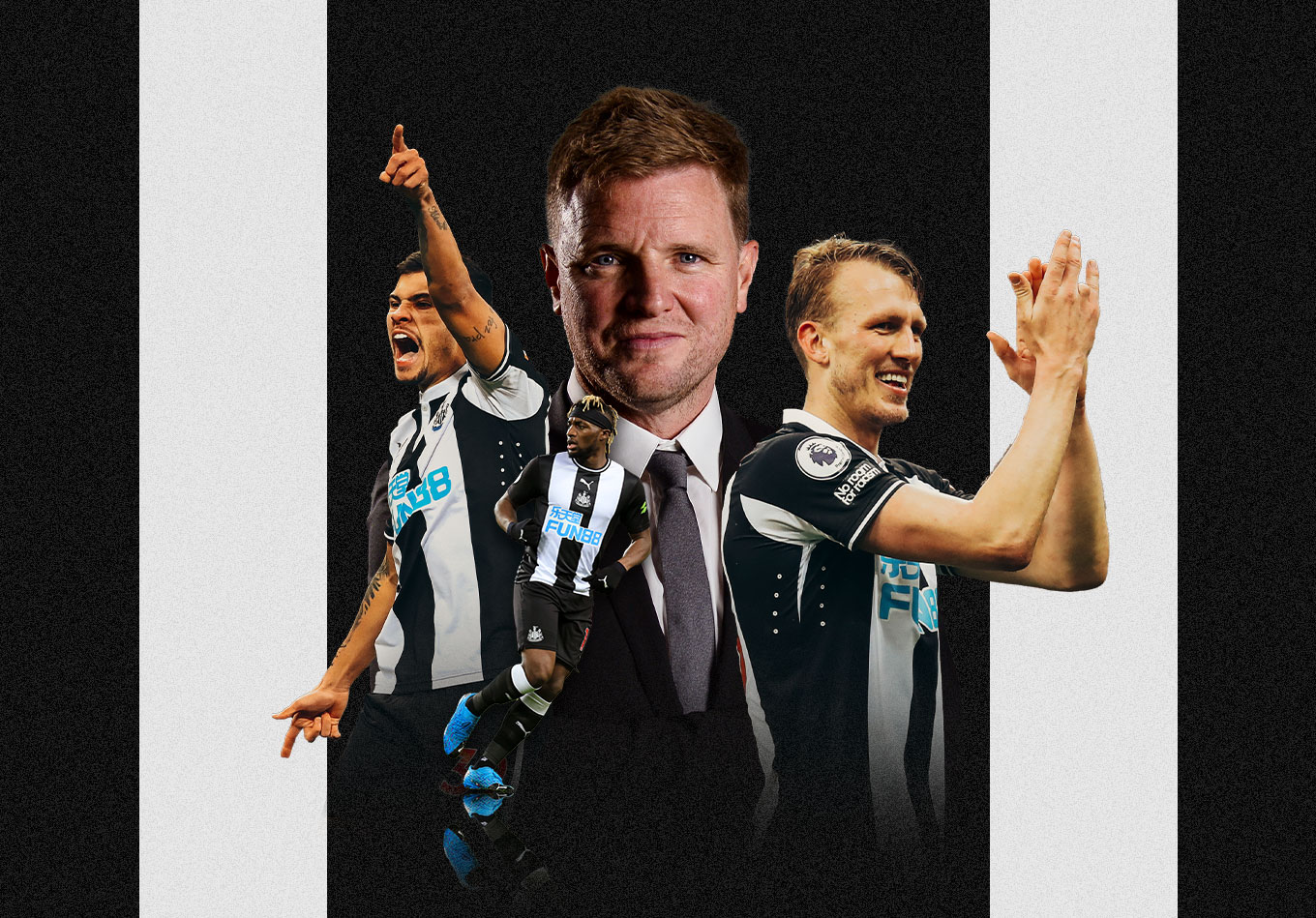Newcastle United have taken 12 points from their last six matches, two more than in their previous 18 combined, in a dramatic turnaround that points to the tactical achievements of Eddie Howe and the impact of his January signings. But if we want to know what exactly has changed, and why Newcastle suddenly look like a mid-table club ready to take on all-comers, we need to isolate the last four games – when the ‘Jonjo-Joe-Joe’ era began.
The two matches before that, 1-1 draws with Manchester United and Watford, were distinctly different from what we have seen in the four since, when Howe has settled on a midfield combination (Jonjo Shelvey, Joe Willock, and Joelinton) and aggressive tactical style that was not present in these two games. In fact, up until then Newcastle had scarcely improved from the confused football of Howe’s predecessor Steve Bruce.
Stuck Between a Rock and a Hard Place
During the second half of the 2020-21 campaign, Bruce began to shift towards a more attacking strategy, abandoning the ultra-deep defensive shape for a system that took greater care of possession and hoped to create chances in a more expansive fashion.
It didn’t work. Instead, Newcastle were caught between a rock and a hard place, lacking the tactical sophistication or player quality to create chances while leaving themselves more open to conceding chances. Worse still, things quickly descended into what looked like a free-for-all, with the defensive line dropping instinctively (after years of Bruce and Rafael Benítez instruction) while the midfield and attacking lines pushed on, creating a hopeless decompression between the lines that made Newcastle easy to beat.
That followed Newcastle into the current season, which is why Howe always looked like a savvy appointment. As Bournemouth manager, he began with a progressive and expansive ideology before gradually sinking into a deeper shape with a greater focus on counter attacks (their average possession share dropped season on season during their five-year stint in the top flight, from 51% to 43%). Consequently, his capacity to coach in both styles made Howe an attractive transitional choice as Newcastle attempt to move from backs-to-the-wall defending to the assertive stylings of a top club.
And yet things barely improved under Howe over the first few months. Newcastle continued to look a little lost, caught between styles and falling back on their conservative, withdrawn instincts. Although comparing Bruce’s eight league games this season to the following 12 reveals Howe’s team pressed slightly more often (19.8 team presses per game, up from 15.5), where their pressures took place shows Howe was struggling to get Newcastle to sit higher up:
| Premier League 2021-22 | Bruce’s First Eight Games | Howe’s First 12 Games |
|---|---|---|
| Average pressures in defensive third (% of total pressures) | 107 (39.4%) | 126 (39.6%) |
| Average pressures in middle third (% of total pressures) | 131 (49.3%) | 138 (46.5%) |
| Average pressures in attacking third (% of total pressures) | 31 (11.0%) | 39 (14.0%) |
Last Four Games: Midfield Rejig and Pressure Applied
But in their last four matches, Newcastle have improved significantly, applying more pressure in the middle third of the pitch and using a new central midfield combination to win the ball higher – in turn leading to more opportunities for direct football into the final third. The below pressure graphics show that shift:
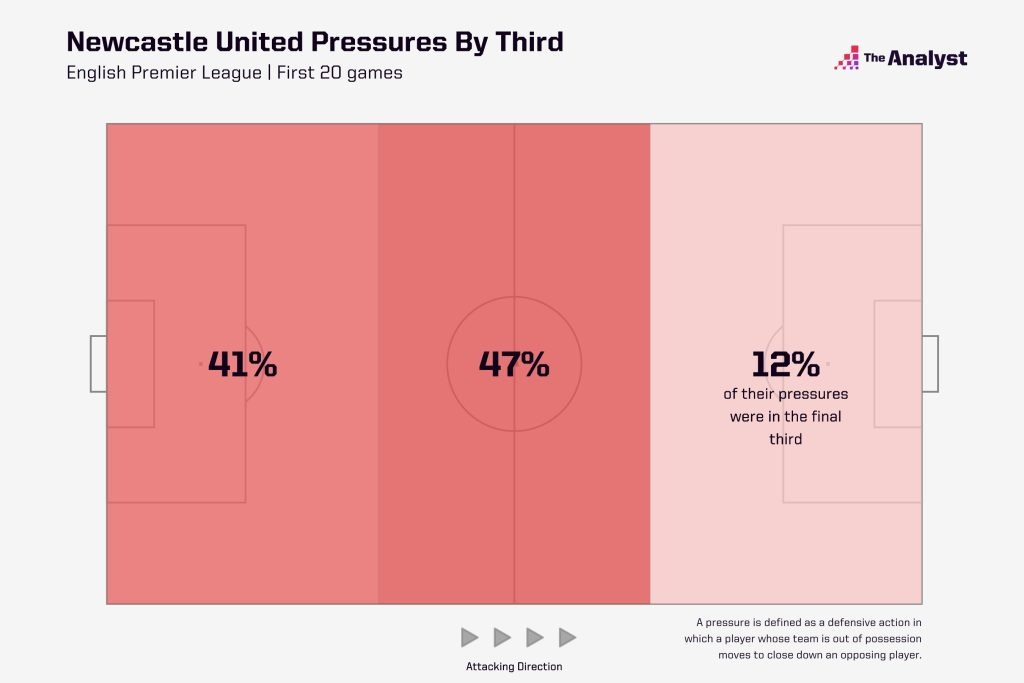
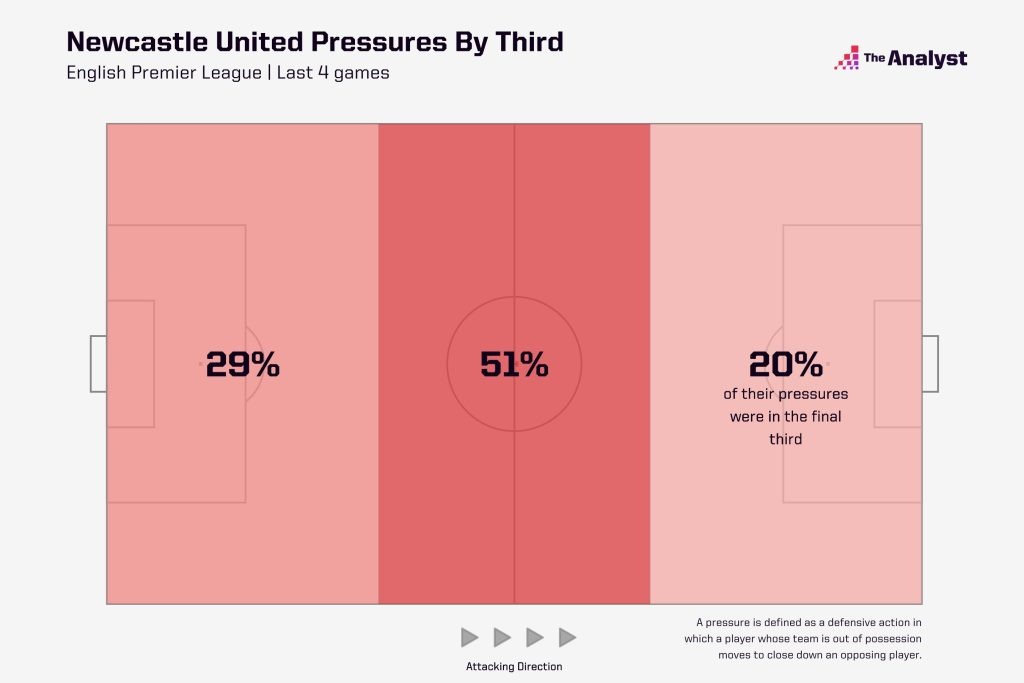
While one important explanation for the shift has been the presence of Kieran Trippier and Dan Burn in defence, helping to raise the defensive line and ensure Newcastle confidently push higher up the pitch, the primary reason is Howe’s selection of Jonjo Shelvey at the base of midfield with Joe Willock and Joelinton either side as No. 8s.
Shelvey’s passing range has been crucial in getting the Newcastle forwards on the ball, but more importantly, Willock and Joelinton have been applying constant pressure to their opposite numbers, winning the midfield battle to provide a launching pad for their team. Comparing averages over the last four league matches to the preceding 20, Newcastle are recording more recoveries (62, up from 54), fouls conceded (12.8, up from 10.2), possessions won in the final third (4.5, up from 3.7), and interceptions (12.8, up from 9.3).
Tellingly, the number of passes they’re allowing their opponents before making a defensive action (PPDA) is down dramatically from 19.0 to 12.1 and their number of high turnovers is up from 3.4 to 4.0 per game. A mixture of a higher defensive line and a more combative central midfield has seen Newcastle pinch the ball more effectively.
The wins over Everton and Aston Villa provide the best examples. André Gomes and Allan, followed by John McGinn and Jacob Ramsey, were targeted with excellent pressure from Newcastle’s dual No. 8s to force concessions as Everton and Villa tried and failed to pass out from the back. Willock and Joelinton made 21 tackles and committed 14 fouls between them across these two games.
Once the ball was won, Howe’s side took advantage of the attacking transition by feeding Allan Saint-Maximin – or by relying on their new press-resistant 8s to carry the ball forward. It is both defensively and offensively that Willock and Joelinton have pushed Newcastle up the pitch and into more assertive, commanding positions, as their carry stats comparing before and after this four-game ‘Jonjo-Joe-Joe’ period show:
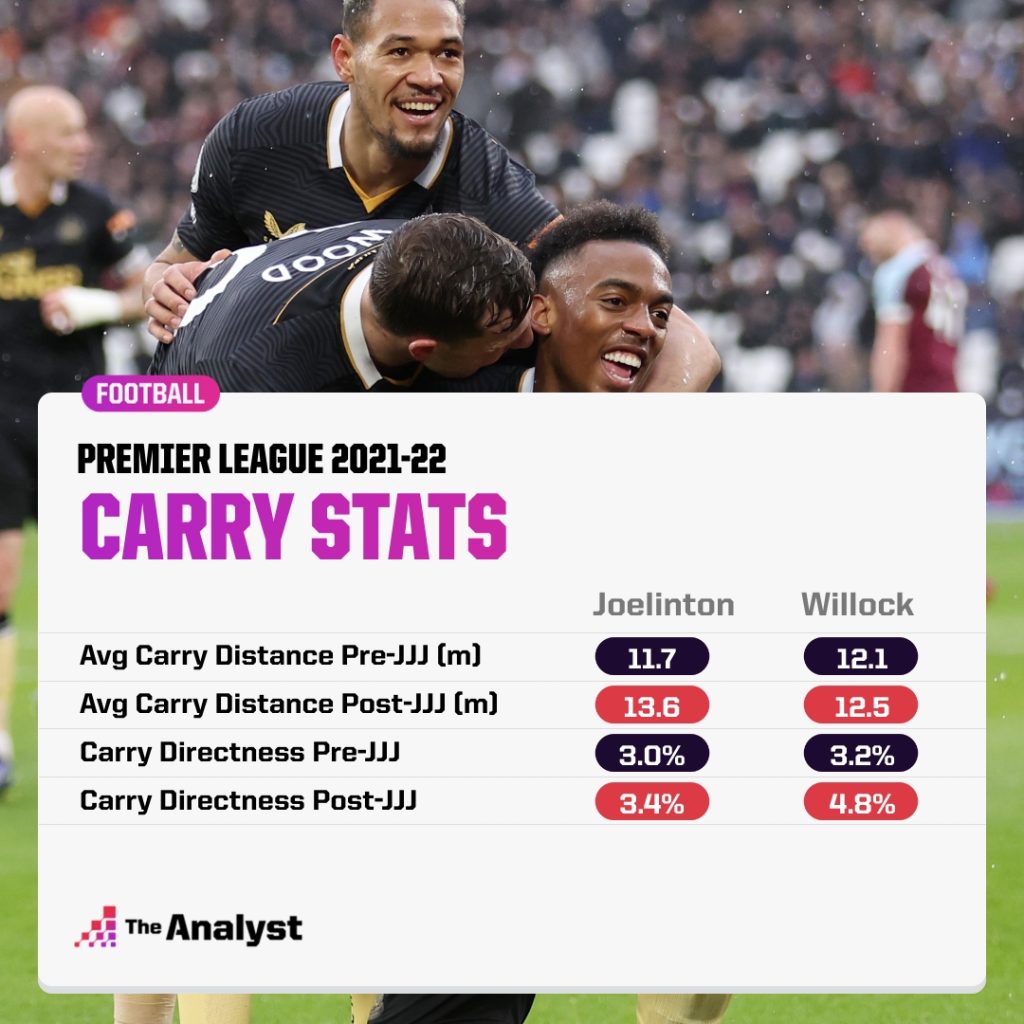
Moving Joelinton into this deeper role has been a revelation for Howe, but it has also created room for Willock to rediscover his best form: with a partner alongside him to provide an outlet, and with Newcastle pushing further up the pitch, the former Arsenal midfielder now has the time and space to advance into the penalty area – hence scoring his first goal of the season last time out.
Upturn Leads to Improvement in Attacking Metrics
With Willock and Joelinton moving Newcastle up the pitch, and Trippier and Burn dragging the defensive line up behind to ensure they remain compressed (unlike those confused months under Bruce), inevitably the Magpies have seen their defensive record improve, sheerly because the ball is further from their goal for longer. Again, comparing averages over the last four league matches to the preceding 20, Newcastle’s shots faced has gone down (from 15.9 to 11.5) while their xGA has fallen (from 1.9 to 0.8).
Another unsurprising knock-on effect is a dramatic improvement in their attacking numbers, as the table below shows:
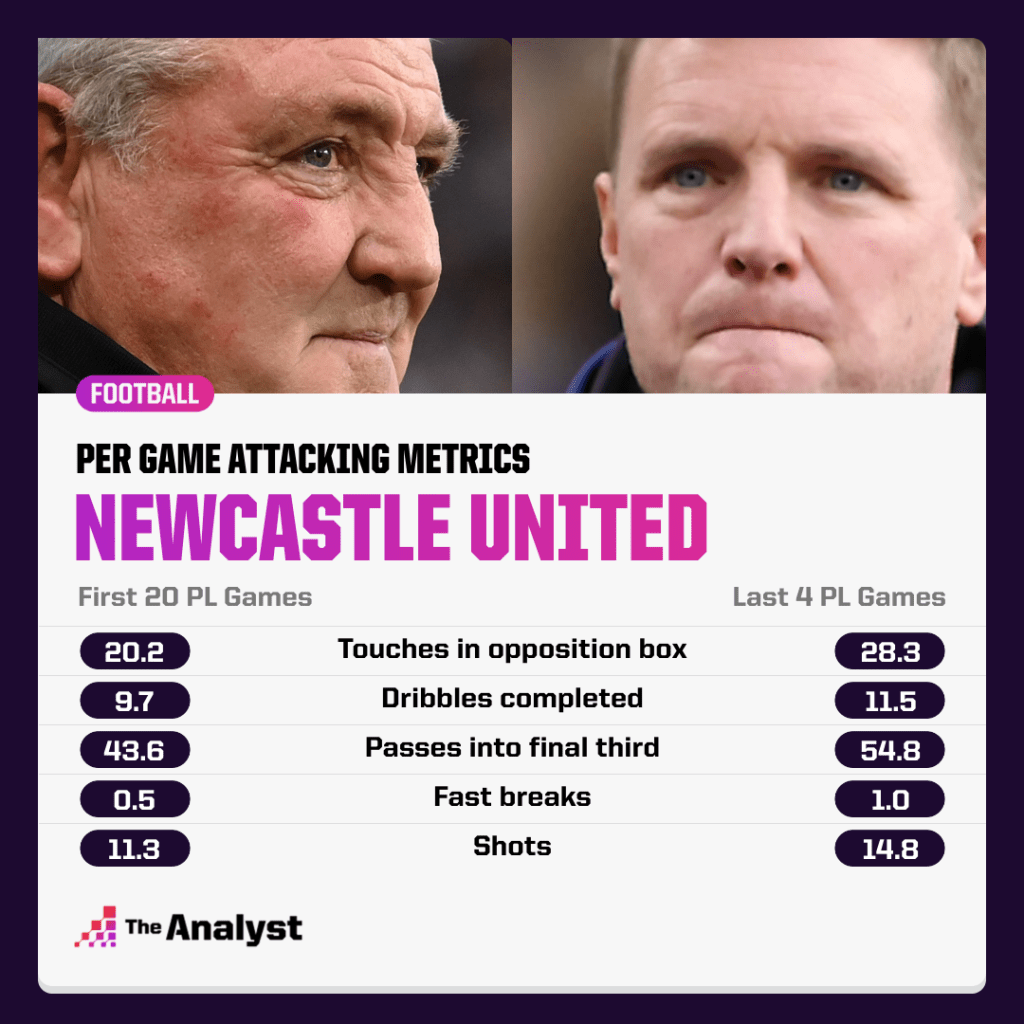
Of course, once the midfield battle has been won, everything then goes through Saint-Maximin, who is enjoying getting more transitional space in higher areas of the pitch. He ranks fourth in the Premier League for carries per 90 (19) and, with Adama Traoré now at Barcelona, he is No. 1 in the division for average carry progress (8.27m). He is also top for chance-creating carries with 53, nine more than the next-best player Mohamed Salah.
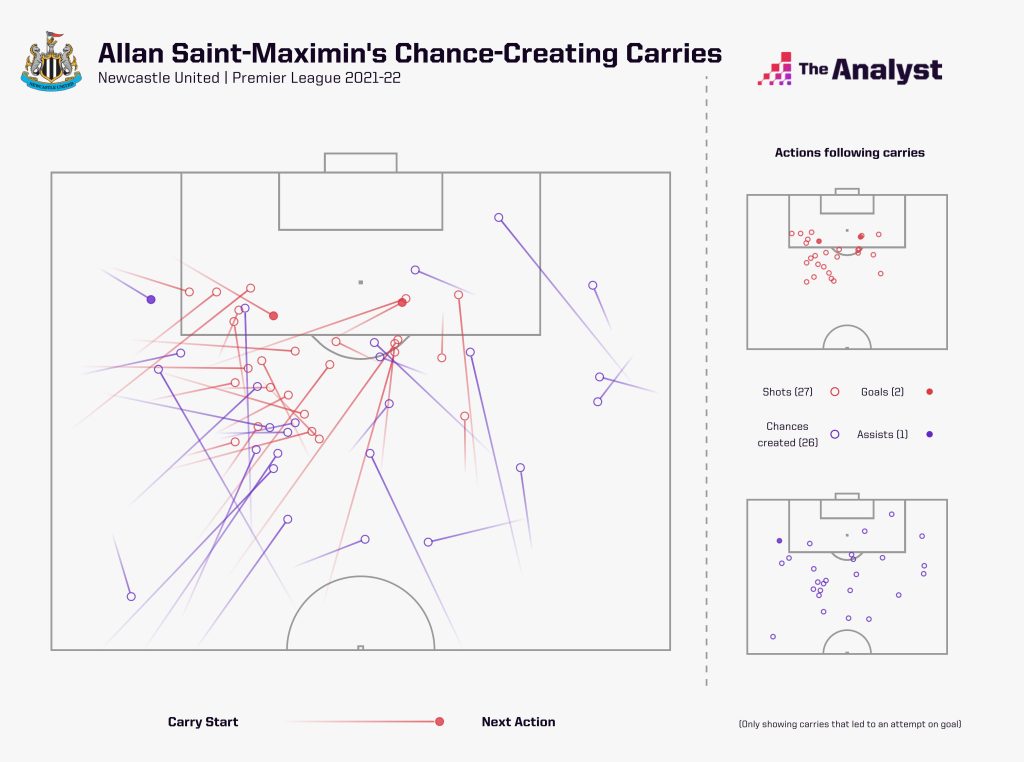
Winning the ball higher up the pitch means releasing Saint-Maximin earlier, and it also means a greater emphasis on a direct route to goal. By so often attacking in transition after a midfield recovery, Newcastle are now moving more vertically.
Their number of 10+ open-play pass sequences has dropped from 4.6 per game to 2.5 per game over the last four matches and their build-up attacks are down from 1.0 to 0.5 per game, while the average metres per second progressed up the pitch during their sequences has risen from 1.5 to 1.9 and the average progress of their sequences has gone up from 10.9 metres to 11.7.
In summary, Newcastle’s newfound aggression through midfield and a higher defensive line has led to a more piercing form of attack, suiting Saint-Maximin’s talents and laying a new tactical foundation under Howe. For the sudden change in fortune following such a slow start, Howe will be thankful for the industrious work of his ‘Jonjo-Joe-Joe’ midfield trio.
